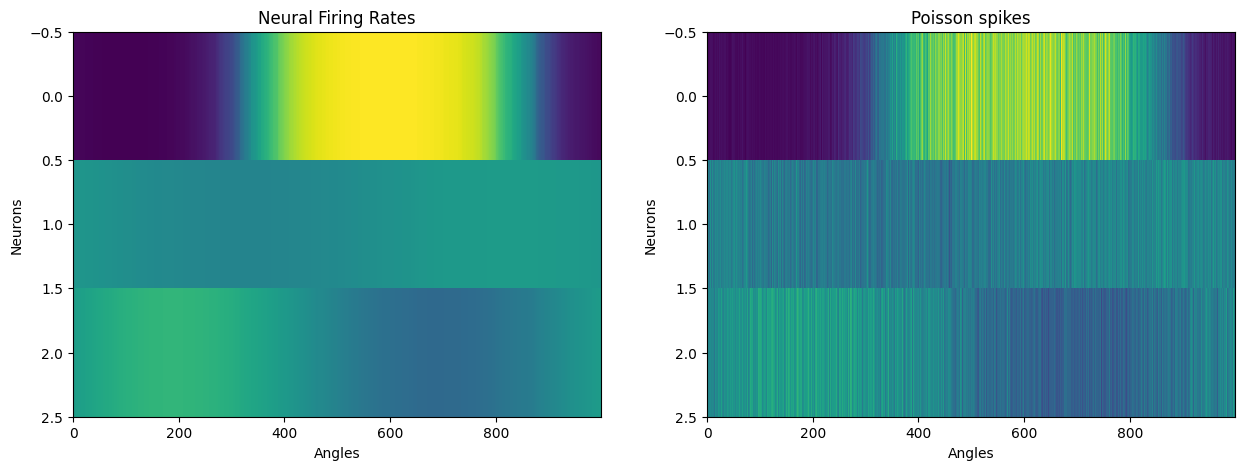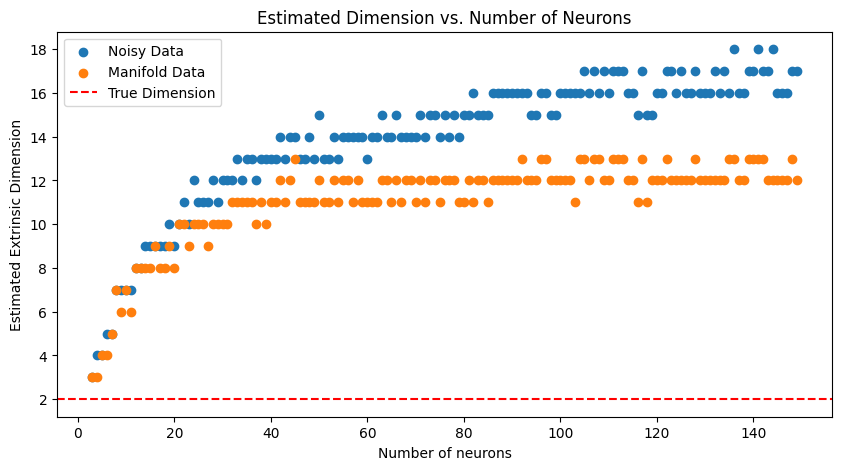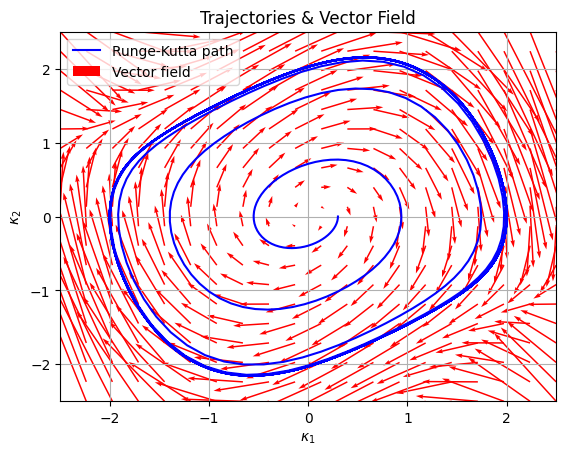Notebook source code: notebooks/01_methods_create_synthetic_data.ipynb
Create Synthetic Neural Manifolds#
This notebook explains how to use the module synthetic to generate points on neural manifolds in neural state space.
Set-up#
In [4]:
import setup
setup.main()
%load_ext autoreload
%autoreload 2
%load_ext jupyter_black
import neurometry.datasets.synthetic as synthetic
import numpy as np
import matplotlib.pyplot as plt
import os
os.environ["GEOMSTATS_BACKEND"] = "pytorch"
import geomstats.backend as gs
import plotly.graph_objects as go
from plotly.subplots import make_subplots
import torch
Working directory: /home/facosta/neurometry/neurometry
Directory added to path: /home/facosta/neurometry
Directory added to path: /home/facosta/neurometry/neurometry
The autoreload extension is already loaded. To reload it, use:
%reload_ext autoreload
The jupyter_black extension is already loaded. To reload it, use:
%reload_ext jupyter_black
set random seed
In [5]:
g_cpu = torch.Generator()
g_cpu.manual_seed(2147483647);
Ring \(\mathcal{S}^1\) in Neural State Space \(\mathbb{R}^3\)#
We use \(N=3\) encoding vectors to represent the recording of \(N=3\) neurons.
We will project the latent manifold \(\mathcal{S}^1\) (minimal embedding dimension \(d=2\)) into \(N\)-dimensional neural state space (\(N=3\)) with a \(d\times N\) matrix \(A\). The entries of \(A\) are randomly sampled from a uniform distribution \(U[-1,1]\) and its columns are random encoding vectors.
Generate points on task manifold (task_points) and neural manifold points (noisy_points, manifold_points):
In [6]:
task_points, intrinsic_coords = synthetic.hypersphere(1, 1000)
noisy_points, manifold_points = synthetic.synthetic_neural_manifold(
points=task_points,
encoding_dim=3,
nonlinearity="sigmoid",
scales=gs.array([5, 3, 1]),
)
Plot:
In [7]:
num_points = 1000
x = task_points[:, 0]
y = task_points[:, 1]
z = np.zeros(num_points)
angles = torch.atan2(task_points[:, 1], task_points[:, 0])
normalized_angles = angles / (2 * np.pi) + 1 / 2
colors = plt.cm.hsv(normalized_angles)
N = 3
place_angles = np.linspace(0, 2 * np.pi, N, endpoint=False)
encoding_matrix = gs.vstack((gs.cos(place_angles), gs.sin(place_angles)))
vectors = [encoding_matrix[:, i] for i in range(N)]
cm = plt.get_cmap("twilight")
vector_colors = [cm(1.0 * i / N) for i in range(N)]
vector_colors = [
"rgb({}, {}, {})".format(int(r * 255), int(g * 255), int(b * 255))
for r, g, b, _ in vector_colors
]
scatter1 = go.Scatter3d(
x=x, y=y, z=z, mode="markers", marker=dict(size=5, color=colors), name="Data Points"
)
lines_and_cones = []
for idx, (vector, color) in enumerate(zip(vectors, vector_colors)):
lines_and_cones.append(
go.Scatter3d(
x=[0, vector[0]],
y=[0, vector[1]],
z=[0, 0],
mode="lines",
line=dict(color=color, width=5),
name=f"Encoding Vector {idx+1}",
)
)
lines_and_cones.append(
go.Cone(
x=[vector[0]],
y=[vector[1]],
z=[0],
u=[vector[0] / 10],
v=[vector[1] / 10],
w=[0],
showscale=False,
colorscale=[[0, color], [1, color]],
sizemode="absolute",
sizeref=0.1,
)
)
x = noisy_points[:, 0]
y = noisy_points[:, 1]
z = noisy_points[:, 2]
print(f"mean firing rate: {torch.mean(noisy_points):.2f} Hz")
scatter2 = go.Scatter3d(
x=x,
y=y,
z=z,
mode="markers",
marker=dict(size=5, color=colors),
name="Neural activations",
)
fig = make_subplots(
rows=1, cols=2, specs=[[{"type": "scatter3d"}, {"type": "scatter3d"}]]
)
# Add the first set of traces (scatter1 and lines_and_cones) to the first subplot
fig.add_traces(
[scatter1] + lines_and_cones,
rows=[1] * (len([scatter1]) + len(lines_and_cones)),
cols=[1] * (len([scatter1]) + len(lines_and_cones)),
)
# Add the second scatter (scatter2) to the second subplot
fig.add_trace(scatter2, row=1, col=2)
reference_frequency = 200
fig.update_layout(
scene1=dict(
aspectmode="cube",
xaxis=dict(range=[-1.2, 1.2], title="Feature 1"),
yaxis=dict(range=[-1.2, 1.2], title="Feature 2"),
zaxis=dict(range=[-1.2, 1.2], title=""),
),
scene2=dict(
aspectmode="cube",
xaxis=dict(
range=[-reference_frequency * 1.2, reference_frequency * 1.2],
title="Neuron 1 firing rate",
),
yaxis=dict(
range=[-reference_frequency * 1.2, reference_frequency * 1.2],
title="Neuron 2 firing rate",
),
zaxis=dict(
range=[-reference_frequency * 1.2, reference_frequency * 1.2],
title="Neuron 3 firing rate",
),
),
margin=dict(l=0, r=0, b=0, t=0),
title_text="",
annotations=[
dict(
text="Feature Space",
xref="paper",
yref="paper",
x=0.25,
y=0.95,
showarrow=False,
font=dict(size=20),
),
dict(
text="Neural Space",
xref="paper",
yref="paper",
x=0.75,
y=0.95,
showarrow=False,
font=dict(size=20),
),
],
)
fig.show()
mean firing rate: 100.48 Hz
Plot neuron tuning curves:
In [8]:
sorted_indices = torch.argsort(angles)
sorted_data_by_angles = manifold_points[sorted_indices, :]
fig, axs = plt.subplots(1, 2, figsize=(15, 5))
axs[0].imshow(sorted_data_by_angles.T, aspect="auto", interpolation="none")
axs[0].set_xlabel("Angles")
axs[0].set_ylabel("Neurons")
axs[0].set_title("Neural Firing Rates")
sorted_noisy_data_by_angles = noisy_points[sorted_indices, :]
axs[1].imshow(sorted_noisy_data_by_angles.T, aspect="auto", interpolation="none")
axs[1].set_xlabel("Angles")
axs[1].set_ylabel("Neurons")
axs[1].set_title("Poisson spikes");

Cylinder (\(\mathcal{S}^1 \times [0,1]\)) in Neural State Space \(\mathbb{R}^3\)#
In [9]:
cylinder_points, intrinsic_coords = synthetic.cylinder(num_points)
x = cylinder_points[:, 0]
y = cylinder_points[:, 1]
z = cylinder_points[:, 2]
scatter = go.Scatter3d(x=x, y=y, z=z, mode="markers", marker=dict(size=5))
fig = go.Figure(data=[scatter])
fig.update_layout(
title={
"text": "Cylinder",
"y": 0.5,
"x": 0.1,
"xanchor": "center",
"yanchor": "top",
"font": dict(size=25),
},
scene=dict(
aspectmode="cube",
xaxis=dict(range=[-1.2, 1.2], title="Feature 1"),
yaxis=dict(range=[-1.2, 1.2], title="Feature 2"),
zaxis=dict(range=[-1.2, 1.2], title="Feature 3"),
),
margin=dict(l=0, r=0, b=0, t=0),
)
fig.show()
Flat torus \(\mathcal{T}^2\) in Neural State Space \(\mathbb{R}^3\)#
We propose to encode the 2-dimensional flat torus in \(N\)-dimensional neural state space, where \(N = 3\) neurons.
In [10]:
num_points = 1000
torus_points, intrinsic_coords = synthetic.hypertorus(2, num_points, radii=[1, 1])
N = 3
encoding_matrix = synthetic.random_encoding_matrix(4, N)
encoded_data = synthetic.encode_points(torus_points, encoding_matrix)
scales = 2 * gs.ones(N)
sigmoid_data = synthetic.apply_nonlinearity(encoded_data, "sigmoid", scales=scales)
x = sigmoid_data[:, 0]
y = sigmoid_data[:, 1]
z = sigmoid_data[:, 2]
scatter = go.Scatter3d(x=x, y=y, z=z, mode="markers", marker=dict(size=5))
fig = go.Figure(data=[scatter])
fig.update_layout(
title={
"text": "Torus",
"y": 0.5,
"x": 0.1,
"xanchor": "center",
"yanchor": "top",
"font": dict(size=25),
},
scene=dict(
aspectmode="cube",
xaxis=dict(range=[-1.2, 1.2], title="Feature 1"),
yaxis=dict(range=[-1.2, 1.2], title="Feature 2"),
zaxis=dict(range=[-1.2, 1.2], title="Feature 3"),
),
margin=dict(l=0, r=0, b=0, t=0),
)
fig.show()
Estimate Extrinsic Dimension of Neural Manifold#
Here, we use skdim to estimate the extrinsic dimension of a ring (circle) manifold embedded in neural state space \(\mathbb{R}^N\) where the number of neurons \(N\) can vary.
We observe whether the estimated extrinsic dimension varies with \(N\).
In [11]:
import skdim
num_points = 5000
circle_points, intrinsic_coords = synthetic.hypersphere(1, num_points)
def f(points):
thetas = gs.arctan2(points[:, 1], points[:, 0])
amplitudes = 1 + 0.6 * np.cos(12 * thetas)
return amplitudes.unsqueeze(-1) * points
transformed_circle_points = f(circle_points)
Ns = list(range(3, 150))
noisy_dim_estimates = []
manifold_dim_estimates = []
for N in Ns:
scales = gs.abs(gs.random.normal(4, 2, N))
noisy_points, manifold_points = synthetic.synthetic_neural_manifold(
transformed_circle_points, N, "tanh", fano_factor=0.1, scales=scales
)
noisy_lpca = skdim.id.lPCA(ver="ratio", alphaRatio=0.999).fit(noisy_points)
manifold_lpca = skdim.id.lPCA(ver="ratio", alphaRatio=0.999).fit(manifold_points)
noisy_dim_estimates.append(noisy_lpca.dimension_)
manifold_dim_estimates.append(manifold_lpca.dimension_)
if N == 3:
# make 3d plot with plotly
fig = go.Figure()
fig.add_trace(
go.Scatter3d(
x=manifold_points[:, 0],
y=manifold_points[:, 1],
z=manifold_points[:, 2],
mode="markers",
marker=dict(size=5),
name="3d neural space",
)
)
fig.show()
fig, ax = plt.subplots(1, 1, figsize=(10, 5))
ax.scatter(Ns, noisy_dim_estimates, label="Noisy Data")
ax.scatter(Ns, manifold_dim_estimates, label="Manifold Data")
ax.axhline(y=2, color="r", linestyle="--", label="True Dimension")
ax.legend()
ax.set_xlabel("Number of neurons")
ax.set_ylabel("Estimated Extrinsic Dimension")
ax.set_title("Estimated Dimension vs. Number of Neurons")
# ax.set_xlim([3, Ns[-1]])
# ax.set_ylim([0, Ns[-1]]);
INFO:numexpr.utils:Note: detected 128 virtual cores but NumExpr set to maximum of 64, check "NUMEXPR_MAX_THREADS" environment variable.
INFO:numexpr.utils:Note: NumExpr detected 128 cores but "NUMEXPR_MAX_THREADS" not set, so enforcing safe limit of 8.
INFO:numexpr.utils:NumExpr defaulting to 8 threads.
Out [11]:
Text(0.5, 1.0, 'Estimated Dimension vs. Number of Neurons')

Synthetic Neural Activity Encoding: Van der Pol Oscillator#
In [12]:
def runge_kutta_4(g_1, g_2, kappa_1_0, kappa_2_0, t_0, t_n, h):
t_values = np.arange(t_0, t_n + h, h)
kappa_1_values = []
kappa_2_values = []
kappa_1 = kappa_1_0
kappa_2 = kappa_2_0
for t in t_values:
kappa_1_values.append(kappa_1)
kappa_2_values.append(kappa_2)
k1_1 = h * g_1(kappa_1, kappa_2, t)
k1_2 = h * g_2(kappa_1, kappa_2, t)
k2_1 = h * g_1(kappa_1 + 0.5 * k1_1, kappa_2 + 0.5 * k1_2, t)
k2_2 = h * g_2(kappa_1 + 0.5 * k1_1, kappa_2 + 0.5 * k1_2, t)
k3_1 = h * g_1(kappa_1 + 0.5 * k2_1, kappa_2 + 0.5 * k2_2, t)
k3_2 = h * g_2(kappa_1 + 0.5 * k2_1, kappa_2 + 0.5 * k2_2, t)
k4_1 = h * g_1(kappa_1 + k3_1, kappa_2 + k3_2, t)
k4_2 = h * g_2(kappa_1 + k3_1, kappa_2 + k3_2, t)
kappa_1 += (1 / 6) * (k1_1 + 2 * k2_1 + 2 * k3_1 + k4_1)
kappa_2 += (1 / 6) * (k1_2 + 2 * k2_2 + 2 * k3_2 + k4_2)
return t_values, kappa_1_values, kappa_2_values
In [13]:
def g_1(kappa_1, kappa_2, t):
return kappa_2
mu = 0.4
def g_2(kappa_1, kappa_2, t):
return -kappa_1 + mu * (1 - kappa_1**2) * kappa_2
In [14]:
t_0, t_n = 0, 100
h = 0.1
plt.figure()
plt.legend()
plt.xlabel("$\kappa_1$")
plt.ylabel("$\kappa_2$")
plt.title("Trajectories & Vector Field")
# plt.quiver(X, Y, U, V, scale=20, color="r", label="Vector field")
kappa_1_0, kappa_2_0 = 0.3, 0
t_values, kappa_1_values, kappa_2_values = runge_kutta_4(
g_1, g_2, kappa_1_0, kappa_2_0, t_0, t_n, h
)
plt.plot(kappa_1_values, kappa_2_values, "b-", label="Runge-Kutta path")
plt.xlim((-2.5, 2.5))
plt.ylim((-2.5, 2.5))
# show gridlines
plt.grid(True)
x_min, x_max = -2.5, 2.5
y_min, y_max = -2.5, 2.5
x_range = np.linspace(x_min, x_max, 20)
y_range = np.linspace(y_min, y_max, 20)
t_range = np.linspace(0, 2 * np.pi, 20)
X, Y = np.meshgrid(x_range, y_range)
U = g_1(X, Y, 0)
V = g_2(X, Y, 0)
plt.quiver(X, Y, U, V, scale=20, color="r", label="Vector field")
plt.legend();

In [15]:
# make a np array of shape (num_points, 2) from the lists kappa_1_values and kappa_2_values
kappa_values = np.array([kappa_1_values, kappa_2_values]).T
In [16]:
noisy_points, manifold_points = synthetic.synthetic_neural_manifold(
points=kappa_values,
encoding_dim=3,
nonlinearity="sigmoid",
scales=gs.array([5, 3, 1]),
)
In [17]:
# make 3d plot with plotly of the noisy points
# x = noisy_points[:, 0]
# y = noisy_points[:, 1]
# z = noisy_points[:, 2]
x = manifold_points[:, 0]
y = manifold_points[:, 1]
z = manifold_points[:, 2]
scatter = go.Scatter3d(x=x, y=y, z=z, mode="markers", marker=dict(size=5))
fig = go.Figure(data=[scatter])
fig.update_layout(
title={
"text": "Noisy Neural Activations",
"y": 0.5,
"x": 0.1,
"xanchor": "center",
"yanchor": "top",
"font": dict(size=25),
},
# scene=dict(
# aspectmode="cube",
# xaxis=dict(range=[-1.2, 1.2], title="Feature 1"),
# yaxis=dict(range=[-1.2, 1.2], title="Feature 2"),
# zaxis=dict(range=[-1.2, 1.2], title="Feature 3"),
# ),
margin=dict(l=0, r=0, b=0, t=0),
)
fig.show()
In [18]:
# from gtda.homology import WeakAlphaPersistence, VietorisRipsPersistence
# from gtda.diagrams import PairwiseDistance
# from gtda.plotting import plot_diagram, plot_heatmap
# import neurometry.datasets.synthetic as synthetic
# import time
# homology_dimensions = (
# 0,
# 1,
# 2,
# )
# VR = VietorisRipsPersistence(
# metric="cosine", homology_dimensions=homology_dimensions, coeff=47
# )
# gtda_start = time.time()
# gtda_vr_diagrams = VR.fit_transform([manifold_points])
# gtda_end = time.time()
# print(
# f"Time to compute Vietoris-Rips persistence diagrams in giotto-tda: {gtda_end - gtda_start:.2f}"
# )
# fig = plot_diagram(
# gtda_vr_diagrams[-1],
# plotly_params={
# "title": "Vietoris-Rips Persistence Diagram, Van der Pol Oscillator"
# },
# )
# fig.update_layout(title="Vietoris-Rips Persistence Diagram, Van der Pol Oscillator")
In [19]:
# from gtda.homology import WeightedRipsPersistence
# homology_dimensions = (
# 0,
# 1,
# 2,
# )
# WR = WeightedRipsPersistence(
# metric="cosine", homology_dimensions=homology_dimensions, coeff=47
# )
# gtda_start = time.time()
# gtda_wr_diagrams = WR.fit_transform([manifold_points])
# gtda_end = time.time()
# print(
# f"Time to compute Weighted-Rips persistence diagrams in giotto-tda: {gtda_end - gtda_start:.2f}"
# )
# fig = plot_diagram(
# gtda_wr_diagrams[-1],
# plotly_params={
# "title": "Weighted-Rips Persistence Diagram, Van der Pol Oscillator"
# },
# )
# fig.update_layout(title="Weighted-Rips Persistence Diagram, Van der Pol Oscillator")